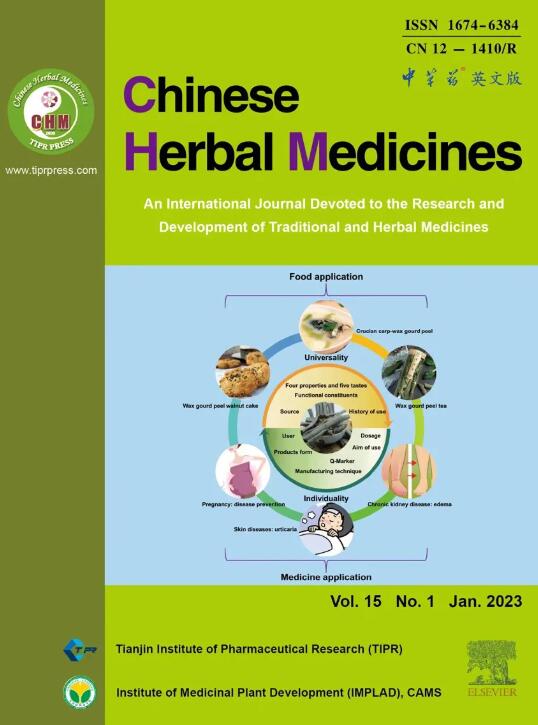天然产物支架衍生的分子胶的研究进展:化学、靶点和分子机制
IF 4.7
4区 医学
Q1 CHEMISTRY, MEDICINAL
引用次数: 0
摘要
中药的作用机制尚不清楚。历史上,中医药的研究主要集中在探索有效成分作用于单一靶点的机制。然而,尚不足以解释这些中药活性成分治疗疾病的复杂机制。近年来,分子胶理论的出现为解决这一问题提供了新的策略。mg是一种小分子,可以促进蛋白质之间在其界面上的相互作用。MGs的特点是在不同的蛋白质结构之间建立联系,从而实现化学介导的接近效应,从而触发广泛的生物功能。天然产物是自然环境中数十亿年进化过程的结果。因此,天然产物的广泛结构多样性使它们成为丰富的镁元素来源,包括聚酮、萜类、类固醇、木脂素、有机酸、生物碱和其他类。目前,一些知名的天然mg药物,包括免疫抑制剂环孢素A (CsA)和他克莫司(FK506),以及抗癌药物紫杉醇,已被纳入临床实践。与此同时,新技术的进步正在推动从天然产物中发现新的mg。因此,我们主要总结了近年来报道的越来越多的天然来源的mg,并根据化学结构类型对它们进行了分类。此外,中药的主要来源是天然产品。天然mg的发现有望为阐明中药功效背后的分子机制提供新的视角。综上所述,本综述旨在从可能影响中药和现代药物开发的天然产物的角度提供见解。本文章由计算机程序翻译,如有差异,请以英文原文为准。
Research advancements in molecular glues derived from natural product scaffolds: Chemistry, targets, and molecular mechanisms
The mechanism of action of traditional Chinese medicine (TCM) remains unclear. Historically, research on TCM has mainly focused on exploring the mechanisms of active components acting on single targets. However, it is insufficient to explain the complex mechanisms by which these active components in TCM treat diseases. In recent years, the emergence of molecular glues (MGs) theory has provided new strategies to address this issue. MGs are small molecules that can promote interactions between proteins at their interface. The characteristic of MGs is to establish connections between diverse protein structures, thereby enabling a chemically-mediated proximity effect that triggers a wide spectrum of biological functions. Natural products are the result of billions of years of evolutionary processes in the natural environment. Thus, the extensive structural diversity of natural products renders them a rich source of MGs, including polyketides, terpenoids, steroids, lignans, organic acids, alkaloids and other classes. Currently, several well-known natural MGs, including the immunosuppressants cyclosporin A (CsA) and tacrolimus (FK506), as well as the anticancer agent taxol, have been incorporated into clinical practice. Meanwhile, the advancement of new technologies is propelling the discovery of novel MGs from natural products. Thus, we primarily summarize a growing variety of MGs from natural origins reported in recent years and categorize them based on the chemical structural types. Moreover, the main sources of TCM are natural products. The discovery of natural MGs promises to provide a new perspective for the elucidation of the molecular mechanism behind the efficiency of TCM. In summary, this review aims to provide insights from the perspective of natural products that could potentially influence TCM and modern drug development.
求助全文
通过发布文献求助,成功后即可免费获取论文全文。
去求助
来源期刊

Chinese Herbal Medicines
CHEMISTRY, MEDICINAL-
CiteScore
4.40
自引率
5.30%
发文量
629
审稿时长
10 weeks
期刊介绍:
Chinese Herbal Medicines is intended to disseminate the latest developments and research progress in traditional and herbal medical sciences to researchers, practitioners, academics and administrators worldwide in the field of traditional and herbal medicines. The journal's international coverage ensures that research and progress from all regions of the world are widely included.
CHM is a core journal of Chinese science and technology. The journal entered into the ESCI database in 2017, and then was included in PMC, Scopus and other important international search systems. In 2019, CHM was successfully selected for the “China Science and Technology Journal Excellence Action Plan” project, which has markedly improved its international influence and industry popularity. CHM obtained the first impact factor of 3.8 in Journal Citation Reports (JCR) in 2023.
 求助内容:
求助内容: 应助结果提醒方式:
应助结果提醒方式:


